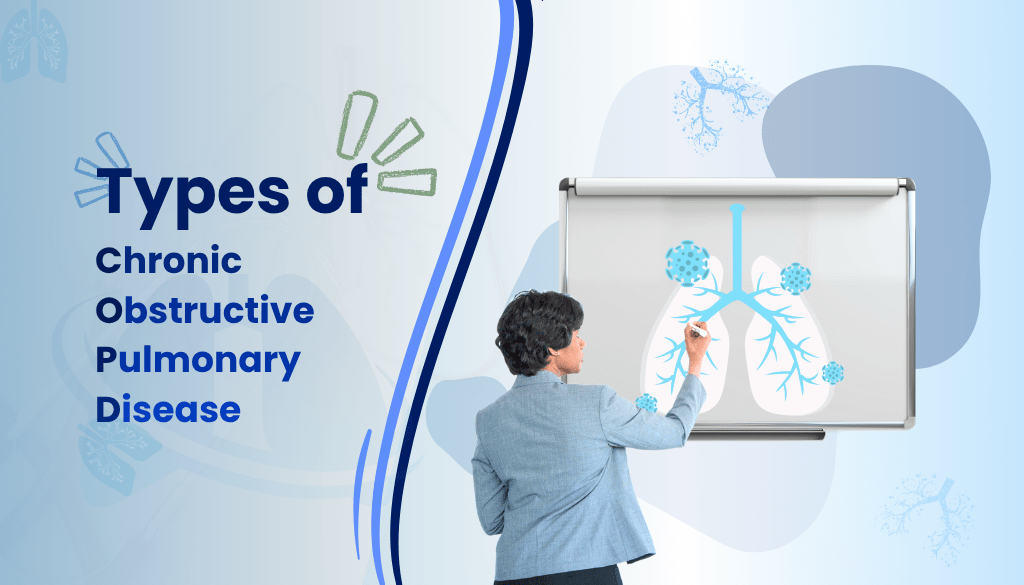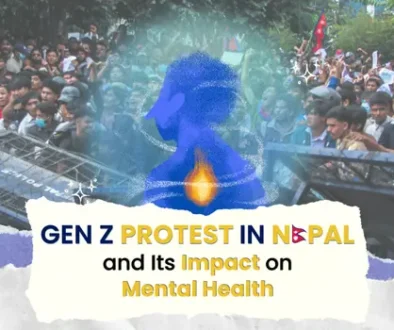Types of COPD (Chronic Obstructive Pulmonary Disease)

Last updated on May 16th, 2025 at 11:46 am
Introduction
Chronic Obstructive Pulmonary Disease, in short COPD, is a long-term lung condition that affects millions of people worldwide. COPD are mainly of two types: emphysema and chronic bronchitis. While chronic bronchitis affects the airways, emphysema targets the air sacs in the lungs. And knowing which form you have, you can get more effective treatment for your breathing problems.
Key Highlights:
- COPD includes chronic bronchitis and emphysema, affecting airways and alveoli differently.
- Smoking plays the main role in COPD, but pollution, irritants, and genetics also play a role.
- COPD symptoms like cough and breathlessness develop slowly but indicate serious lung damage.
- Early diagnosis through tests like spirometry is vital for better COPD management.
- Preventing COPD involves quitting smoking, reducing exposure to irritants, and regular health care.
What Is COPD?
Chronic Obstructive Pulmonary Disease is a persistent respiratory condition that affects the lungs over an extended period. Its main cause is smoking, but long-term exposure to air pollution, dust, or fumes can also lead to COPD.
Symptoms often include a persistent cough, shortness of breath, and wheezing. While there’s no cure for it, but effective treatments can help manage the symptoms, slow its progression, and improve quality of life.
Types of Chronic Obstructive Pulmonary Disease
Chronic Obstructive Pulmonary Disease (COPD) mainly includes two conditions: chronic bronchitis and emphysema. Chronic bronchitis results in ongoing airway inflammation, causing continuous coughing and excess mucus buildup. Emphysema harms the lung’s air sacs, making breathing difficult.
![]()
Chronic Bronchitis
Chronic bronchitis involves inflammation or swelling of the bronchial tubes, leading to persistent coughing and mucus production. This condition results from prolonged irritation of the airways, mostly due to smoking and exposure to pollutants. The inflammation causes the lining of the bronchial tubes to swell and produce excess mucus, which can obstruct airflow and make breathing difficult.
Emphysema
Emphysema is characterised by damage to the alveoli, the small air sacs in the lungs that handle gas exchange. Over time, the walls between the alveoli break down, leading to larger but fewer air sacs. This reduces the surface area available for oxygen absorption, causing shortness of breath and difficulty exhaling.
Causes of Chronic Obstructive Pulmonary Disease
Several factors contribute to the development of COPD:
- Tobacco Smoking: The leading cause of COPD, responsible for up to 90% of cases.
- Air Pollution: Prolonged exposure to polluted air harms the lungs.
- Occupational Exposure: Inhaling dust, chemicals, or fumes at the workplace increases risk.
- Secondhand Smoke: Exposure to smoke from others can be harmful.
- Recurrent Respiratory Infections: Frequent lung infections during childhood can impair lung development.
- Genetic Factors: A rare genetic disorder, i.e. alpha-1 antitrypsin deficiency (a genetic disorder that occurs because of low levels of a protein that protects the lungs), can raise the risk of lung damage.
How to Know If You Have COPD?
While both types of COPD often develop slowly and affect different parts of the lungs. But they have similar symptoms, which include:
- Persistent productive cough
- Excess mucus production
- Shortness of breath, especially during physical activities.
- Chest discomfort or tightness
- Fatigue
- Wheezing
- Bluish lips or fingernails (cyanosis)
- Weight loss
When to Consult a Pulmonologist?
If you experience persistent respiratory symptoms, especially if you’re a smoker or have a history of exposure to lung irritants, it’s crucial to consult a pulmonologist. Also, if you notice any of the signs mentioned above, seek medical attention and get a Pulmonary Function Test (PFT) immediately. This can help in early diagnosis and management, slowing disease progression.
Don’t Wait Until It’s Too Late
Get your breathing checked today and add years to your life.
Who Is at Higher Risk of COPD?
Certain groups are more susceptible to developing COPD:
- Individuals over the age of 65.
- Those exposed to air pollution.
- Workers in environments with chemicals, dust, or fumes.
- People with alpha-1 antitrypsin deficiency.
- Individuals who had multiple respiratory infections during childhood.
How to Prevent It?
While COPD is not entirely preventable, certain measures can reduce risk:
- Avoid Tobacco Smoke: Quitting smoking is the most effective way to prevent COPD.
- Limit Exposure to Lung Irritants: Minimise contact with pollutants, dust, and chemical fumes.
- Maintain a Healthy Lifestyle: Regular exercise and a balanced diet support lung health.
- Stay Up-to-Date with Vaccinations: Vaccines like the flu shot can prevent respiratory infections that may worsen COPD.
- Regular Health Check-Ups: Routine medical visits can help detect COPD early.
Conclusion
Chronic bronchitis and emphysema are the primary forms of COPD, mostly caused by smoking and environmental factors. You can’t cure it, but early diagnosis and proper treatment help manage symptoms and slow its progress. Look for signs like a persistent cough or shortness of breath, and see a pulmonologist early.
Remember, the Earlier You Diagnose It, the More Years You’ll Add to Your Life
So why wait? Book your affordable Spirometry or PFT test to check your lung health today.
FAQs
What are the 5 chronic respiratory diseases?
The five major chronic respiratory diseases are:
- Chronic Obstructive Pulmonary Disease (COPD)
- Asthma
- Respiratory Allergies
- Occupational Lung Diseases
- Pulmonary Hypertension
How to diagnose COPD?
You can diagnose COPD using a combination of tests and evaluations as listed below:
- Spirometry: It calculates how much air you can blow out and how fast, helping to check if there is airflow blockage and how severe it is.
- Additional Tests: Depending on the spirometry results and clinical evaluation, doctors may order chest X-rays or CT scans to visualise lung structures, blood tests to assess oxygen levels, and genetic tests if a hereditary condition like alpha-1 antitrypsin deficiency is suspected.
What are the 3 risk factors of COPD?
Here are three key risk factors for developing Chronic Obstructive Pulmonary Disease (COPD):
- Tobacco Smoking
- Exposure to Air Pollutants
- Occupational Exposure to Dust and Chemicals
What is another name for COPD?
People also refer to Chronic Obstructive Pulmonary Disease (COPD) by other names, including:
- Chronic Obstructive Airway Disease (COAD)
- Chronic Obstructive Lung Disease (COLD)
- Chronic Airflow Obstruction
- Chronic Bronchitis
- Emphysema
What are the 4 symptoms of COPD?
Here are four common symptoms of Chronic Obstructive Pulmonary Disease (COPD):
- Shortness of Breath (Dyspnea), especially during physical activities.
- Frequent Respiratory Infections
- Chronic Cough and Excessive Mucus Production
- Chest tightness, wheezing, and a whistling or squeaky sound when breathing.

